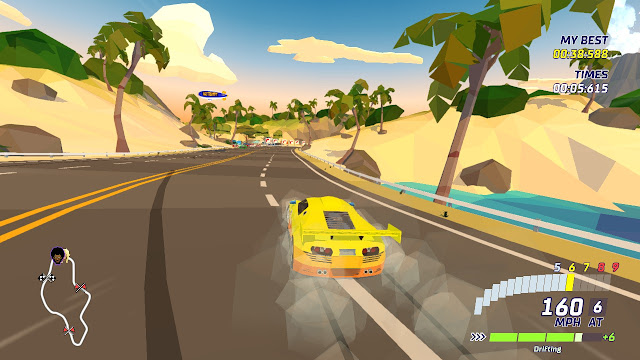Hotshot Tales, Part 3: A Marathon Track?
Having player Hotshot Racing to 100% completion, I started revisiting the track layouts and noticed something unique to the Coast track set. Specifically, it should be theoretically possible to combine sections from all four tracks to create a gigantic supertrack that didn't intersect with itself. So without further ado, here's how it would be like.
The start/finish line would be on the same location (and facing in the same direction) as it would be for Sea View, the fourth track in the Coast environment (although as an alternative, it could instead share its location with The Marina or Ocean World, with the latter's starting grid facing in the opposite direction to that of the former). However, after the first turn, the track diverges onto the Ocean World route (the second track in the set) instead of going straight on, and continues to use much of that track's length before going straight on (instead of turning right) to take the final turn of The Marina (the first track in the set) in reverse. From there, it rejoins with Sea View's route all the way to the finish line. It might even be possible to extend this track even further by diverging one last time onto a reversed section of Heated Highway (the third track in the set), but since this track intersects with Sea View, this would change the final turn into a very tight 90-degree left-hander. However, given that most of the Desert tracks (and even some of the Jungle tracks) have at least one sharp 90-degree turn, this change would not be as difficult to implement as you might think.
Most of the corner sequences from this new mega-track would be familiar to those who have experienced its constituent tracks. However, the reversed hairpin would be unique, given that whereas it's a right-hander with a downhill exit in The Marina, it would now be a left-hander with an uphill approach. You'd still be likely to enter it at a high speed, though, making heavy braking a necessity. Moreover, the approach to the next turn (which leads back to Sea View) will be faster, and hence more challenging, although the left/right sequence that follows would remain as-is. Finally, if the section from Heated Highway is added to the lap, instead of a simple right-hand hairpin, there will be a 90-degree left feeding almost directly into a second hairpin turn, this time to the right. The resulting corner sequence would again require quick direction changes, and lead to the last long straight before the final corner. Speaking of which, it should be treated as a mirror image of the fourth turn (the one immediately before the double-apex hairpin) on the Downtown layout of the Desert track: slam on the brakes, steer hard towards the left, then straighten out quickly. However, this new 90-degree turn leads to a straight instead of a hairpin, so boosting away from the apex is a lot safer as long as you keep the revs up.
Here's how it would feel like. Starting in the same place as Sea View, you turn left at the first fork instead of going straight on...
Above, from top: How the first few corners at a hypothetical Coast mega-track would look like - the fast right-hander at the start of Sea View, followed by a left-right chicane onto Ocean World's layout.
...before heading left instead of right at the start of Ocean World's lap.
Above: Approaching the start/finish line at Ocean World. The mega-track would not head right, but instead continue straight onto the final turn at The Marina... Below: which would be an uphill left-hand hairpin instead of the downhill right-hand hairpin shown here (essentially the next turn in reverse).
Head straight on for a while, then turn right to rejoin Sea View, before turning left again onto the first part of Heated Highway.
Above: This is the fork that leads to Sea View - my proposed mega-track would turn left instead of right.
The left-right sequence leads to one more long "straight", followed by a fast right-hander before the final turn...
Above, from top: Imagine these sections of track taken in reverse order and direction - this would be the final part of my hypothetical Coast mega-track.
...a tight 90-degree left that's a mirror-image of the fourth turn at Desert's Downtown layout that leads back to Sea View to finish the lap.
Above: This is where the last corner of my proposed mega-track on the Coast map would be.
This leaves one last question: Where do you place the checkpoints (which mark the end of the current sector and the start of the next one)? I'd suggest placing the first one in the same place as the second checkpoint at Ocean World (which is just after leaving the aquarium), and the second one just after the right-hand turn that leads back to Sea View.
In short, it's unlikely that Lucky Mountain Games or Sumo Digital (the developers of this game) will ever introduce such a long track to Hotshot Racing in the future, considering that they wanted all of their track layouts to be relatively short and sweet (in keeping with the old-school arcade nature of the game), but it's nice to know that they could have done so without compromising what makes this game so special.

























